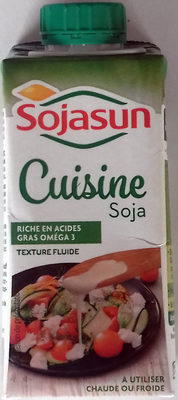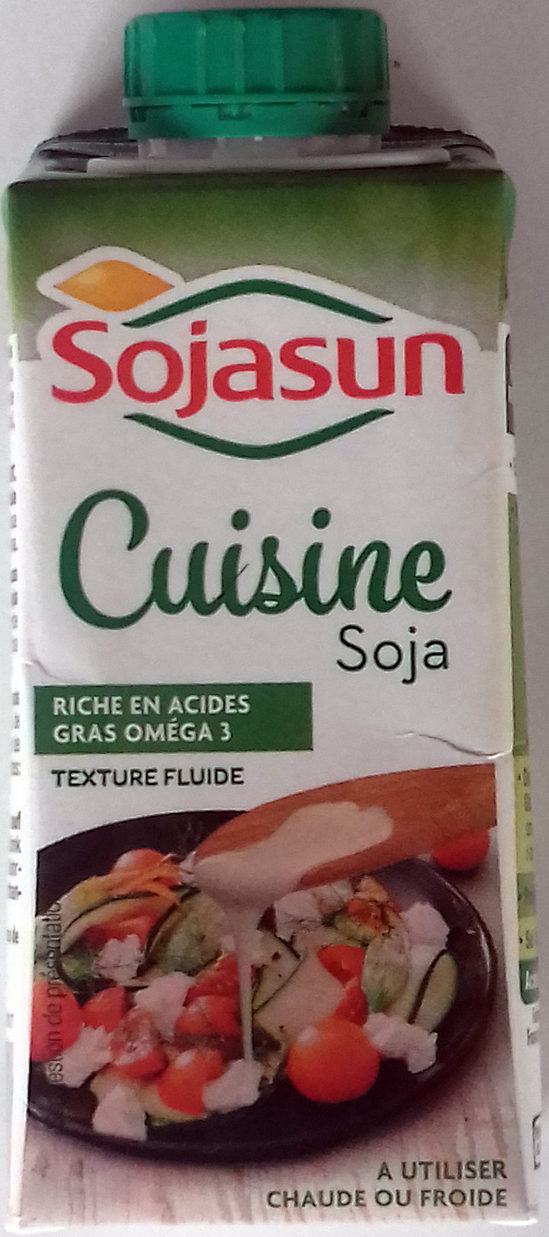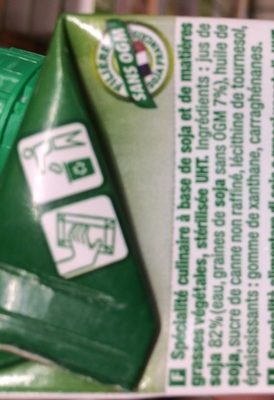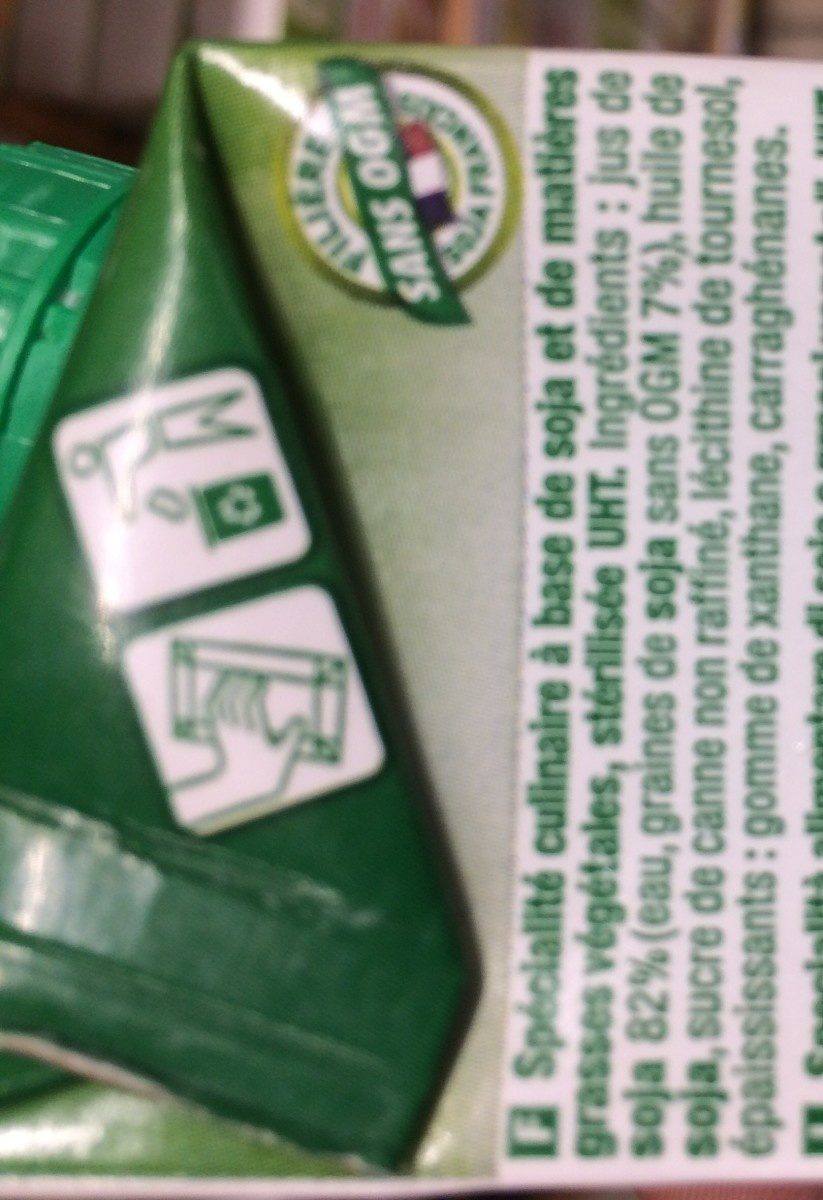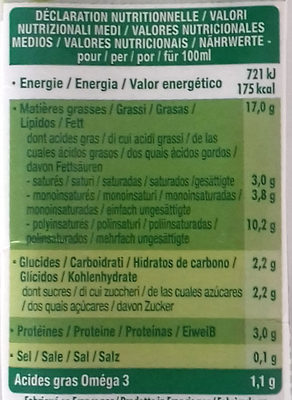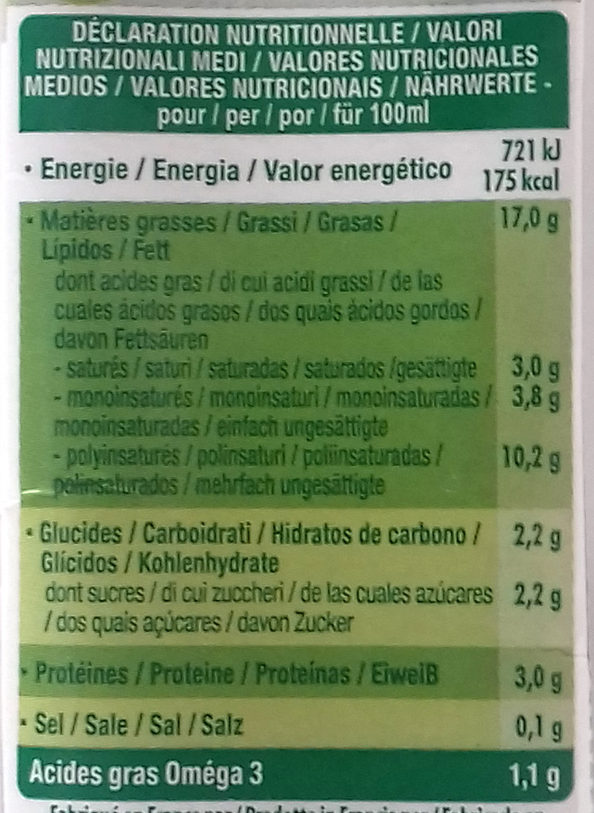Help us make food transparency the norm!
As a non-profit organization, we depend on your donations to continue informing consumers around the world about what they eat.
The food revolution starts with you!
Cuisine soja - Sojasun - 20 cl
Cuisine soja - Sojasun - 20 cl
This product page is not complete. You can help to complete it by editing it and adding more data from the photos we have, or by taking more photos using the app for Android or iPhone/iPad. Thank you!
×
Barra-kodea: 3273227088190 (EAN / EAN-13)
Izen arrunta: Spécialité culinaire a base de soja et de matières grasse végétales, stérilisée UHT
Kopurua: 20 cl
Ontziratzea: en:multilayer-composite, Tetra Pak
Markak: Sojasun
Kategoriak: en:Plant-based foods and beverages, en:Plant-based foods, en:Plant-based creams, en:Plant-based creams for cooking, en:Soy-based creams for cooking
Etiketak, ziurtagiriak, sariak:
en:No GMOs, Omega-3, fr:Soja Français, en:FSC, en:FSC Mix, en:Green Dot, High in Omega 3, en:Made in France

Origin of ingredients: Frantzia
Manufacturing or processing places: Francia
Traceability code: FSC-C014047
Link to the product page on the official site of the producer: http://www.sojasun.com/produit/sojasun-c...
Dendak: Carrefour, Magasins U
Matching with your preferences
Health
Osagaiak
-
9 ingredients
: jus de soja 82% (eau, graines de soja sans OGM 7%), huile de soja, sucre de canne non raffiné, lécithine de tournesol, épaississants: gomme de xanthane, carraghénanes.Alergenoak: en:Soybeans
Food processing
-
Ultra processed foods
Elements that indicate the product is in the 4 - Ultra prozesatutako elikagaiak eta edariak group:
- Gehigarria: E322
- Gehigarria: E407
- Gehigarria: E415
- Osagaia: Thickener
Food products are classified into 4 groups according to their degree of processing:
- Prozesatu gabeko edo ahalik eta gutxien prozesatutako elikagaiak
- Sukaldaritzako osagaiak prozesatu
- Prozesatutako jakiak
- Ultra processed foods
The determination of the group is based on the category of the product and on the ingredients it contains.
Gehigarriak
-
E322
Lecithin: Lecithin -UK: , US: , from the Greek lekithos, "egg yolk"- is a generic term to designate any group of yellow-brownish fatty substances occurring in animal and plant tissues, which are amphiphilic – they attract both water and fatty substances -and so are both hydrophilic and lipophilic-, and are used for smoothing food textures, dissolving powders -emulsifying-, homogenizing liquid mixtures, and repelling sticking materials.Lecithins are mixtures of glycerophospholipids including phosphatidylcholine, phosphatidylethanolamine, phosphatidylinositol, phosphatidylserine, and phosphatidic acid.Lecithin was first isolated in 1845 by the French chemist and pharmacist Theodore Gobley. In 1850, he named the phosphatidylcholine lécithine. Gobley originally isolated lecithin from egg yolk—λέκιθος lekithos is "egg yolk" in Ancient Greek—and established the complete chemical formula of phosphatidylcholine in 1874; in between, he had demonstrated the presence of lecithin in a variety of biological matters, including venous blood, in human lungs, bile, human brain tissue, fish eggs, fish roe, and chicken and sheep brain. Lecithin can easily be extracted chemically using solvents such as hexane, ethanol, acetone, petroleum ether, benzene, etc., or extraction can be done mechanically. It is usually available from sources such as soybeans, eggs, milk, marine sources, rapeseed, cottonseed, and sunflower. It has low solubility in water, but is an excellent emulsifier. In aqueous solution, its phospholipids can form either liposomes, bilayer sheets, micelles, or lamellar structures, depending on hydration and temperature. This results in a type of surfactant that usually is classified as amphipathic. Lecithin is sold as a food additive and dietary supplement. In cooking, it is sometimes used as an emulsifier and to prevent sticking, for example in nonstick cooking spray.Source: Wikipedia (Ingeles)
-
E322i - Lezitina
Lecithin: Lecithin -UK: , US: , from the Greek lekithos, "egg yolk"- is a generic term to designate any group of yellow-brownish fatty substances occurring in animal and plant tissues, which are amphiphilic – they attract both water and fatty substances -and so are both hydrophilic and lipophilic-, and are used for smoothing food textures, dissolving powders -emulsifying-, homogenizing liquid mixtures, and repelling sticking materials.Lecithins are mixtures of glycerophospholipids including phosphatidylcholine, phosphatidylethanolamine, phosphatidylinositol, phosphatidylserine, and phosphatidic acid.Lecithin was first isolated in 1845 by the French chemist and pharmacist Theodore Gobley. In 1850, he named the phosphatidylcholine lécithine. Gobley originally isolated lecithin from egg yolk—λέκιθος lekithos is "egg yolk" in Ancient Greek—and established the complete chemical formula of phosphatidylcholine in 1874; in between, he had demonstrated the presence of lecithin in a variety of biological matters, including venous blood, in human lungs, bile, human brain tissue, fish eggs, fish roe, and chicken and sheep brain. Lecithin can easily be extracted chemically using solvents such as hexane, ethanol, acetone, petroleum ether, benzene, etc., or extraction can be done mechanically. It is usually available from sources such as soybeans, eggs, milk, marine sources, rapeseed, cottonseed, and sunflower. It has low solubility in water, but is an excellent emulsifier. In aqueous solution, its phospholipids can form either liposomes, bilayer sheets, micelles, or lamellar structures, depending on hydration and temperature. This results in a type of surfactant that usually is classified as amphipathic. Lecithin is sold as a food additive and dietary supplement. In cooking, it is sometimes used as an emulsifier and to prevent sticking, for example in nonstick cooking spray.Source: Wikipedia (Ingeles)
-
E407
Carrageenan: Carrageenans or carrageenins - karr-ə-gee-nənz, from Irish carraigín, "little rock"- are a family of linear sulfated polysaccharides that are extracted from red edible seaweeds. They are widely used in the food industry, for their gelling, thickening, and stabilizing properties. Their main application is in dairy and meat products, due to their strong binding to food proteins. There are three main varieties of carrageenan, which differ in their degree of sulfation. Kappa-carrageenan has one sulfate group per disaccharide, iota-carrageenan has two, and lambda-carrageenan has three. Gelatinous extracts of the Chondrus crispus -Irish moss- seaweed have been used as food additives since approximately the fifteenth century. Carrageenan is a vegetarian and vegan alternative to gelatin in some applications or may be used to replace gelatin in confectionery.Source: Wikipedia (Ingeles)
-
E415
Xanthan gum: Xanthan gum -- is a polysaccharide with many industrial uses, including as a common food additive. It is an effective thickening agent and stabilizer to prevent ingredients from separating. It can be produced from simple sugars using a fermentation process, and derives its name from the species of bacteria used, Xanthomonas campestris.Source: Wikipedia (Ingeles)
Ingredients analysis
-
en:Palm oil free
No ingredients containing palm oil detected
Unrecognized ingredients: fr:graines-de-soja-sans-ogmSome ingredients could not be recognized.
We need your help!
You can help us recognize more ingredients and better analyze the list of ingredients for this product and others:
- Edit this product page to correct spelling mistakes in the ingredients list, and/or to remove ingredients in other languages and sentences that are not related to the ingredients.
- Add new entries, synonyms or translations to our multilingual lists of ingredients, ingredient processing methods, and labels.
If you would like to help, join the #ingredients channel on our Slack discussion space and/or learn about ingredients analysis on our wiki. Thank you!
-
en:Vegan status unknown
Unrecognized ingredients: en:Soy base, fr:graines-de-soja-sans-ogmSome ingredients could not be recognized.
We need your help!
You can help us recognize more ingredients and better analyze the list of ingredients for this product and others:
- Edit this product page to correct spelling mistakes in the ingredients list, and/or to remove ingredients in other languages and sentences that are not related to the ingredients.
- Add new entries, synonyms or translations to our multilingual lists of ingredients, ingredient processing methods, and labels.
If you would like to help, join the #ingredients channel on our Slack discussion space and/or learn about ingredients analysis on our wiki. Thank you!
-
en:Vegetarian status unknown
Unrecognized ingredients: en:Soy base, fr:graines-de-soja-sans-ogmSome ingredients could not be recognized.
We need your help!
You can help us recognize more ingredients and better analyze the list of ingredients for this product and others:
- Edit this product page to correct spelling mistakes in the ingredients list, and/or to remove ingredients in other languages and sentences that are not related to the ingredients.
- Add new entries, synonyms or translations to our multilingual lists of ingredients, ingredient processing methods, and labels.
If you would like to help, join the #ingredients channel on our Slack discussion space and/or learn about ingredients analysis on our wiki. Thank you!
-
Details of the analysis of the ingredients
We need your help!
Some ingredients could not be recognized.
We need your help!
You can help us recognize more ingredients and better analyze the list of ingredients for this product and others:
- Edit this product page to correct spelling mistakes in the ingredients list, and/or to remove ingredients in other languages and sentences that are not related to the ingredients.
- Add new entries, synonyms or translations to our multilingual lists of ingredients, ingredient processing methods, and labels.
If you would like to help, join the #ingredients channel on our Slack discussion space and/or learn about ingredients analysis on our wiki. Thank you!
: jus de _soja_ 82% (eau, graines de _soja_ sans OGM 7%), huile de _soja_, sucre de canne non raffiné, lécithine de tournesol, épaississants (gomme de xanthane), carraghénanes- jus de _soja_ -> en:soy-base - percent_min: 82 - percent: 82 - percent_max: 82
- eau -> en:water - vegan: yes - vegetarian: yes - ciqual_food_code: 18066 - percent_min: 75 - percent_max: 75
- graines de _soja_ sans OGM -> fr:graines-de-soja-sans-ogm - percent_min: 7 - percent: 7 - percent_max: 7
- huile de _soja_ -> en:soya-oil - vegan: yes - vegetarian: yes - from_palm_oil: no - ciqual_food_code: 17420 - percent_min: 9.2 - percent_max: 18
- sucre de canne non raffiné -> en:unrefined-cane-sugar - vegan: yes - vegetarian: yes - ciqual_proxy_food_code: 31016 - percent_min: 0 - percent_max: 2.2
- lécithine de tournesol -> en:sunflower-lecithin - vegan: yes - vegetarian: yes - percent_min: 0 - percent_max: 2.2
- épaississants -> en:thickener - percent_min: 0 - percent_max: 2.2
- gomme de xanthane -> en:e415 - vegan: yes - vegetarian: yes - percent_min: 0 - percent_max: 2.2
- carraghénanes -> en:e407 - vegan: yes - vegetarian: yes - percent_min: 0 - percent_max: 2.2
en:soya -> en:soya
Elikadura
-
Average nutritional quality
⚠ ️Abisua: zuntz kopurua ez dago zehaztuta, ezin izan dute kontuan izan kalifikaziorako izan dezaketen ekarpen positiboa.⚠ ️Warning: the amount of fruits, vegetables and nuts is not specified on the label, it was estimated from the list of ingredients: 0This product is not considered a beverage for the calculation of the Nutri-Score.
Positive points: 1
- Proteinak: 1 / 5 (balioa: 3, rounded value: 3)
- Fiber: 0 / 5 (balioa: 0, rounded value: 0)
- Fruits, vegetables, nuts, and colza/walnut/olive oils: 0 / 5 (balioa: 0, rounded value: 0)
Negative points: 4
- Energia: 2 / 10 (balioa: 721, rounded value: 721)
- Azukreak: 0 / 10 (balioa: 2.2, rounded value: 2.2)
- Gantz saturatua: 2 / 10 (balioa: 3, rounded value: 3)
- Sodioa: 0 / 10 (balioa: 40, rounded value: 40)
The points for proteins are counted because the negative points are less than 11.
Nutritional score: (4 - 1)
Nutri-Score:
-
Nutrient levels
-
Koipe in moderate quantity (17%)
What you need to know- A high consumption of fat, especially saturated fats, can raise cholesterol, which increases the risk of heart diseases.
Recommendation: Limit the consumption of fat and saturated fat- Choose products with lower fat and saturated fat content.
-
Gantz-azido ase in moderate quantity (3%)
What you need to know- A high consumption of fat, especially saturated fats, can raise cholesterol, which increases the risk of heart diseases.
Recommendation: Limit the consumption of fat and saturated fat- Choose products with lower fat and saturated fat content.
-
Azukre in low quantity (2.2%)
What you need to know- A high consumption of sugar can cause weight gain and tooth decay. It also augments the risk of type 2 diabetes and cardio-vascular diseases.
Recommendation: Limit the consumption of sugar and sugary drinks- Sugary drinks (such as sodas, fruit beverages, and fruit juices and nectars) should be limited as much as possible (no more than 1 glass a day).
- Choose products with lower sugar content and reduce the consumption of products with added sugars.
-
Gatz arrunt in low quantity (0.1%)
What you need to know- A high consumption of salt (or sodium) can cause raised blood pressure, which can increase the risk of heart disease and stroke.
- Many people who have high blood pressure do not know it, as there are often no symptoms.
- Most people consume too much salt (on average 9 to 12 grams per day), around twice the recommended maximum level of intake.
Recommendation: Limit the consumption of salt and salted food- Reduce the quantity of salt used when cooking, and don't salt again at the table.
- Limit the consumption of salty snacks and choose products with lower salt content.
-
-
Nutrition facts
Nutrition facts As sold
for 100 g / 100 mlCompared to: en:Plant-based creams for cooking Energia 721 kj
(175 kcal)+% 26 Koipe 17 g +% 36 Gantz-azido ase 3 g -% 70 Gantz-azido monoasegabe 3,8 g Polyunsaturated fat 10,2 g Omega 3 fat 1.100 mg Carbohydrates 2,2 g -% 42 Azukre 2,2 g - Fiber ? Proteina 3 g +% 205 Gatz arrunt 0,1 g +% 1 Fruits‚ vegetables‚ nuts and rapeseed‚ walnut and olive oils (estimate from ingredients list analysis) 0 %
Ingurumena
-
Eco-Score A - Very low environmental impact
The Eco-Score is an experimental score that summarizes the environmental impacts of food products.→ The Eco-Score was initially developped for France and it is being extended to other European countries. The Eco-Score formula is subject to change as it is regularly improved to make it more precise and better suited to each country.Life cycle analysis
-
Average impact of products of the same category: A (Score: 94/100)
Kategoria: Soy "cream" preparation
Kategoria: Soy "cream" preparation
- PEF environmental score: 0.15 (the lower the score, the lower the impact)
- including impact on climate change: 1.04 kg CO2 eq/kg of product
Stage Impact Agriculture
52.5 %Processing
27.1 %Ontziratzea
7.5 %Transportation
9.5 %Distribution
3.3 %Consumption
0.0 %
Bonuses and maluses
-
Origins of ingredients with a medium impact
Bonus: +10
Environmental policy: +4
Transportation: +6
Origin of the product and/or its ingredients % of ingredients Impact Frantzia 100 %Medium
-
Packaging with a low impact
Malus: -4
Shape Material Recycling Impact Brick Tetra Pak Medium
Eco-Score for this product
-
Impact for this product: A (Score: 100/100)
Produktua: Cuisine soja - Sojasun - 20 cl
Life cycle analysis score: 94
Sum of bonuses and maluses: +6
Final score: 100/100
-
Carbon footprint
-
Equal to driving 0.5 km in a petrol car
104 g CO² per 100g of product
The carbon emission figure comes from ADEME's Agribalyse database, for the category: Soy "cream" preparation (Source: ADEME Agribalyse Database)
Stage Impact Agriculture
48.5 %Processing
24.0 %Ontziratzea
10.5 %Transportation
15.1 %Distribution
1.9 %Consumption
0.0 %
Ontziratzea
-
Packaging with a low impact
-
Packaging parts
Brick (Tetra Pak)
-
Bilgarriaren materialak
Material % Bilgarriaren pisua Bilgarriaren pisua produktuaren 100g-ko
-
Transportation
-
Origins of ingredients
Origins of ingredients with a medium impact
Origin of the product and/or its ingredients % of ingredients Impact Frantzia 100 %Medium
Report a problem
-
Incomplete or incorrect information?
Category, labels, ingredients, allergens, nutritional information, photos etc.
If the information does not match the information on the packaging, please complete or correct it. Open Food Facts is a collaborative database, and every contribution is useful for all.
Datuen iturria
Product added on by kiliweb
Last edit of product page on by worldtest.
Produktuaren orria -gatik editatua dotsuke, magasins-u, neptuno, openfoodfacts-contributors, packbot, quechoisir, roboto-app, scanbot, segundo, yuka.R2E4TFRhRWhpOVVsZ3ZBRXhpbjN4L3hsOWNTRVkxbUhGTEkwSVE9PQ, yuka.YUpJd0NhdFF1L01CbGNkaTdpbVArdDUyeGNXTVdHaVRKOFJCSUE9PQ, yuka.ZmE5WURZRXVxL3Mzc3NZNjd3L2E0dTl5eTdTemRsMndLZHM0SVE9PQ.
